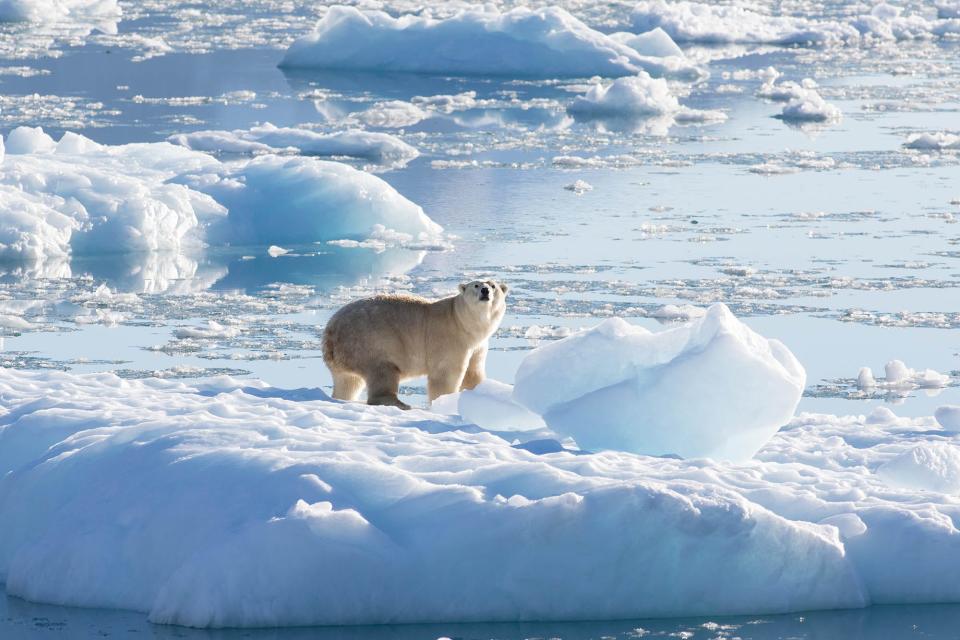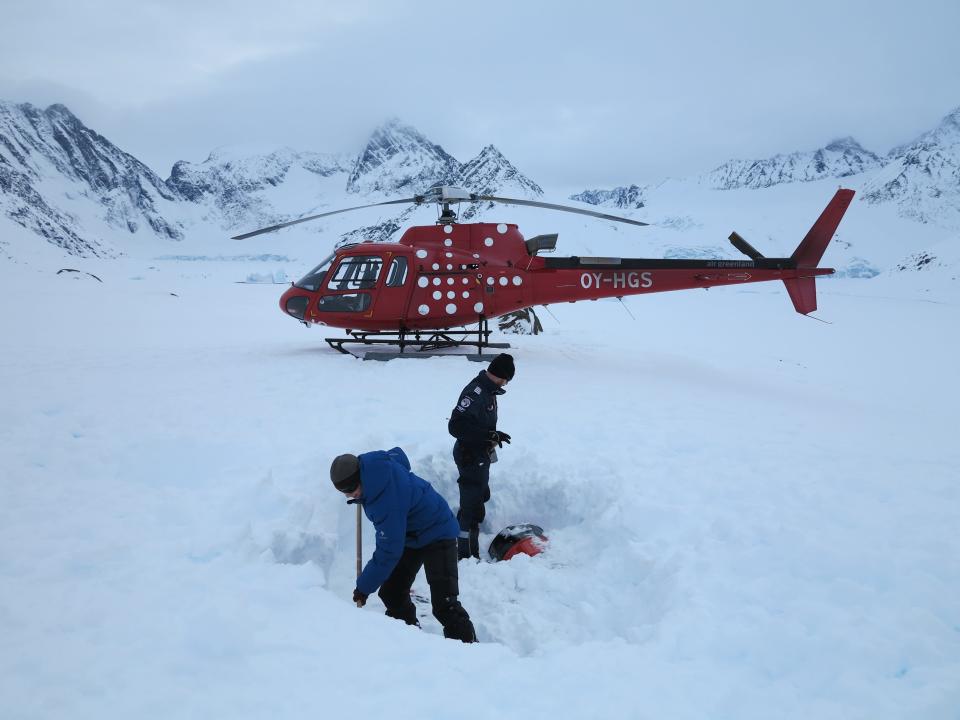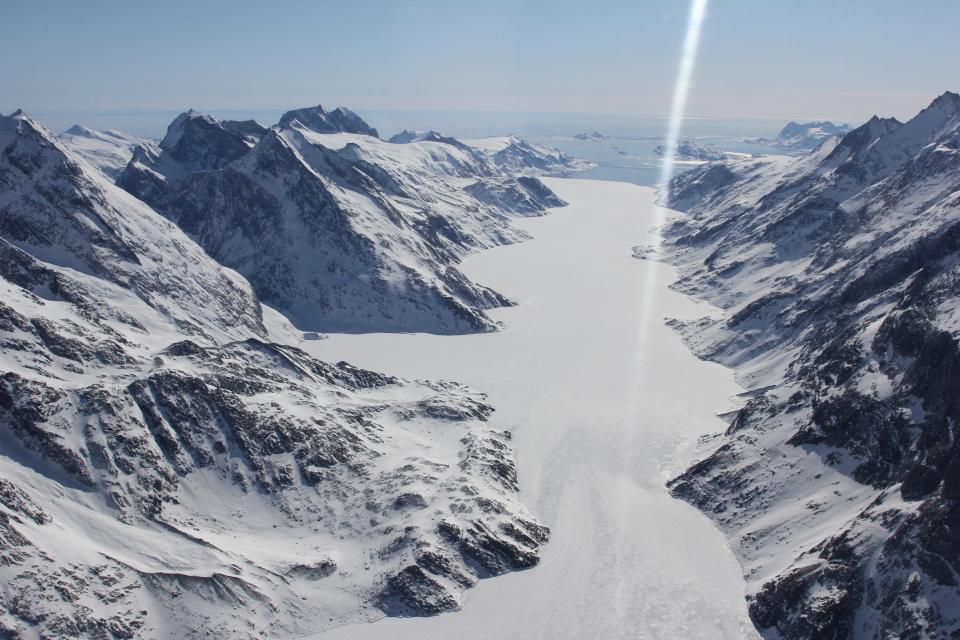Scientists find new population of polar bears hanging on despite rapidly changing climate
A group of polar bears clinging to existence along a remote region of Greenland’s southeastern coast has adapted to life in a perilous zone where thawing glaciers meet melting sea ice and the warming sea.
Whether these bears can continue to survive in their rapidly changing world remains unknown, but scientists who studied them said the polar bears may offer lessons in resilience.
Unlike other polar bears, these bears hunt on both sea ice and freshwater ice, finding refuge in a mix of two icy habitats, the scientists announced Thursday in a paper published in the journal Science. Researchers found the bears' genetics, hunting and other behaviors make them distinct from other polar bear populations around the Arctic, including one to the north on the Greenland coast.

The six-year study was led by Kristin Laidre, an Arctic marine mammal researcher at the University of Washington, in collaboration with the Greenland Institute of Natural Resources and other international collaborators.
Polar bears generally hunt on sea ice, which is rapidly diminishing as the Arctic warms at twice the rate of the rest of the Earth. That raises great concerns about their survival.
“We’re headed for an ice-free Arctic in the summertime,” Laidre said. “What does that mean for polar bears? Where are the places that polar bears will be able to hang on?”
The remote coast of southeastern Greenland might be one example, but she said more research is needed.
She and her collaborators talked with Indigenous people in the region about the bears’ movements and learned the bears experienced “big climate changes, in sea ice, storms and glaciers," she said. They studied genetic samples collected from bears over 34 years by the Indigenous hunters and other researchers.
For three years in a row, over a few weeks each March and April, the researchers conducted dangerous fieldwork. Traveling mostly by helicopter, swooping low in perilous locations and landing on thinning ice, scientists watched as the bears and cubs hunted seals.

Under permits issued by the Greenland government, they felled bears briefly with tranquilizer darts to grab measurements and samples of hair and blood. If conditions were too dangerous or they were low on fuel, they’d shoot a remote biopsy dart into the bear’s rump, which would grab a quick genetic sample before popping off. Satellite collars were placed on female bears to monitor their movements.
The few hundred bears in the region use sea ice for the roughly 100 days when it’s available, Laidre said. That’s too short a period for the bears, so when the sea ice thaws, the bears supplement their diets hunting on freshwater ice in areas where it mixes with the thawing sea ice along the region's coastal fjords.
The freshwater ice slowly moves off the continent’s ice sheet to the coast in the form of glaciers, which calve off icebergs when the glaciers reach the ocean, she said. “There is a whole landscape of that freshwater glacial ice, that's like floating and found at the fronts of glaciers, and it can be many kilometers wide and long.”
Called a glacial melange, the habitat is found in only two locations, Laidre said: Greenland and Svalbard, a Norwegian archipelago in the Arctic Ocean.
Additional warming is projected to lead to declines in polar bears across the Arctic, she said. This research might shed light on the kind of habitat where small numbers of bears might be able to hang on.
The bears in southeast Greenland are the most genetically isolated of the roughly 26,000 polar bears on the planet, the study found. The government of Greenland and the International Union for Conservation of Nature will decide whether the bears are a separate population from the 19 others around the Arctic.
They live in an environment where they’re penned in on all sides, Laidre said. “To the west is the Greenland ice sheet, to the east is open ocean all the way into the north. Along the coast, running south is a fast current.”

Though the glacial melange provides a buffer to sea ice loss in the region, it’s unclear how long that will last because of the rapid change on the ice sheet, she said. The width of the sea ice is declining, and the speed of the southward-flowing current has increased over the past 10 years.
If a bear steps onto an ice floe, it can be quickly swept out of the area, she said.
The same edition of Science features a letter by former polar bear researcher Elizabeth “Lily” Peacock, who discussed the research in southeast Greenland and asked whether a decades-old international conservation agreement will be enough to protect polar bears.
The international agreement was successful in bringing polar bears back from overharvesting, but it isn’t clear whether it will be able to protect the bears from the changing climate, wrote Peacock, an emergency room doctor at Emory University in Atlanta. “If the amount of carbon in the atmosphere doesn’t start to decline, we’ll have less sea ice and (the bears’) numbers will continue to decline into the future.”
No one knows whether the Greenland bears’ unique landscape will be enough to support them. It could be just a bandage or temporary buoy, Peacock told USA TODAY.
“As the climate continues to warm and sea ice disappears, the glacial melange will disappear as well,” she said. “For all we know it, (this population) will blink out in a decade.”
Dinah Voyles Pulver covers climate and environment issues for USA TODAY. She can be reached at dpulver@gannett.com or at @dinahvp on Twitter.
This article originally appeared on USA TODAY: Greenland polar bears offer small hope against climate change threat

